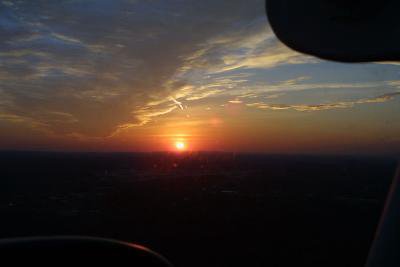The mighty Mammatus
A look at my schedule the other day showed me flying my next trip with a great captain I had the pleasure of working with a few months ago in one of my (and apparently his) most memorable flights yet.
John and I sat in the cockpit in June in Nashville, readying for our second leg of the day. In a few hours, we'd be going home and we were in a jovial mood as the two-day trip had so far gone without a hitch. As the printer spat out the Washington National Airport ATIS, I noticed a mention of ACMAM, something I had never seen before.
"What is that?" I asked John.
Not a clue.
So I pulled out my phone and Googled it.
"Alto Cumulus, Mammatus clouds," I read.
A search for Mammatus clouds yielded intimidating photographs of the dark and menacing clouds. "This ought to be interesting," I said.
"This ought to be interesting," I said.
It was John's leg. He took off and climbed in smooth air and beautiful clear skies to 37,000 feet. We wondered what lay ahead and checked the weather periodically. The ceiling in D.C. was dropping, rain and cumulonimbus clouds were reported in the vicinity and the wind was picking up steadily. But aside from the subsistent note MAM, it looked like the typical stormy summer day.
We pushed on in slightly choppier air. As we neared Washington on the Eldee Three arrival, the bumps grew more intense right around the Eldee intersection. Racing in and out of clouds, we tried to map the storms in the area both with the help of our radar and by visually spotting them.
John zigzagged to avoid a large cell directly over Dulles Airport and we soon made the right turn onto the downwind for Runway 1 at DCA.
Moments later, we were over the river, following a Delta Airlines MD-80 ahead of us. We ran through the approach checklist. Looked like we'd make it in, no problems at all.
The scenery outside the windshield was dramatic. The dark mammatus clouds kept the early afternoon sun from shining through the undercast and it looked like night-time. A dark mass sat just west of the airport, seemingly out of our way.
As we pressed on down the Potomac the bumps grew more violent. I watched the dark maelstrom to our left. It was moving, and moving fast. Right at DCA.
"Don't know if we'll beat it in," I said.
By the time we reached the Wilson Bridge, about 5 miles south of the airport, the dark storm had swallowed the field and the Delta ahead of us completely. The turbulence shook us so violently that reading the instruments became difficult at best.
We reached the edge of the storm, which was thundering toward us, threatening to gobble us in its fury any second now. Just as I was about to suggest we go around, John shoved the throttles forward.
"Flight 1234," a frazzled controller called, "make an immediate right turn, 180 heading, the tower is shaking." In the midst of the mess, I also heard the Delta going around, fighting in the middle of a very angry storm.
As we made the turn, the turbulence made the airplane roll so far that I thought we were about to go inverted. It was a harrowing climb back up through 1,000' but John fought valiantly against the turbulence while I cleaned the airplane up and ran through the appropriate checklists.
Then things got interesting.
"Potomac approach, Flight 1234 on the missed, through 1,500', heading 180."
Silence.
"Approach, Flight 1234 on the missed, 1,500 for 5,000, 180 heading."
Complete silence.
I flicked to another Potomac frequency I was familiar with for the area, but still nothing. Back on the original frequency I tried once more. No controller. Another airliner checked in, but like us received no reply.
Zipping through the clouds with nobody on the frequency was an eery feeling. I briefly spoke to the pilot of the other airliner, all the while calculating our fuel.
Finally a faint voice broke the silence.
The Potomac Approach controller was talking to us from a handheld radio. It seemed the storms had wreaked havoc with the facility's transmitters. He gave us a heading back to the localizer and instructions to hold. We complied, but discussed our options since fuel was now running low.
"We have enough for one approach but we have to land," I hinted at John.
In the hold, the bumps tossed the aircraft like a rag doll. This was too much of a gamble, we decided, and the people in the back had probably had enough. We diverted to Richmond and once again lost communication for a while.
A few minutes later we touched down at our alternate and John personally went to the back to explain our situation to the passengers: We'd have to wait out the weather. Delays, however, were the least of anyone's concerns. I truly believe our passengers were just happy to be down in one piece.
It took us a few more hours, but got them into D.C. later that night.



0 Comments:
Post a Comment
<< Home